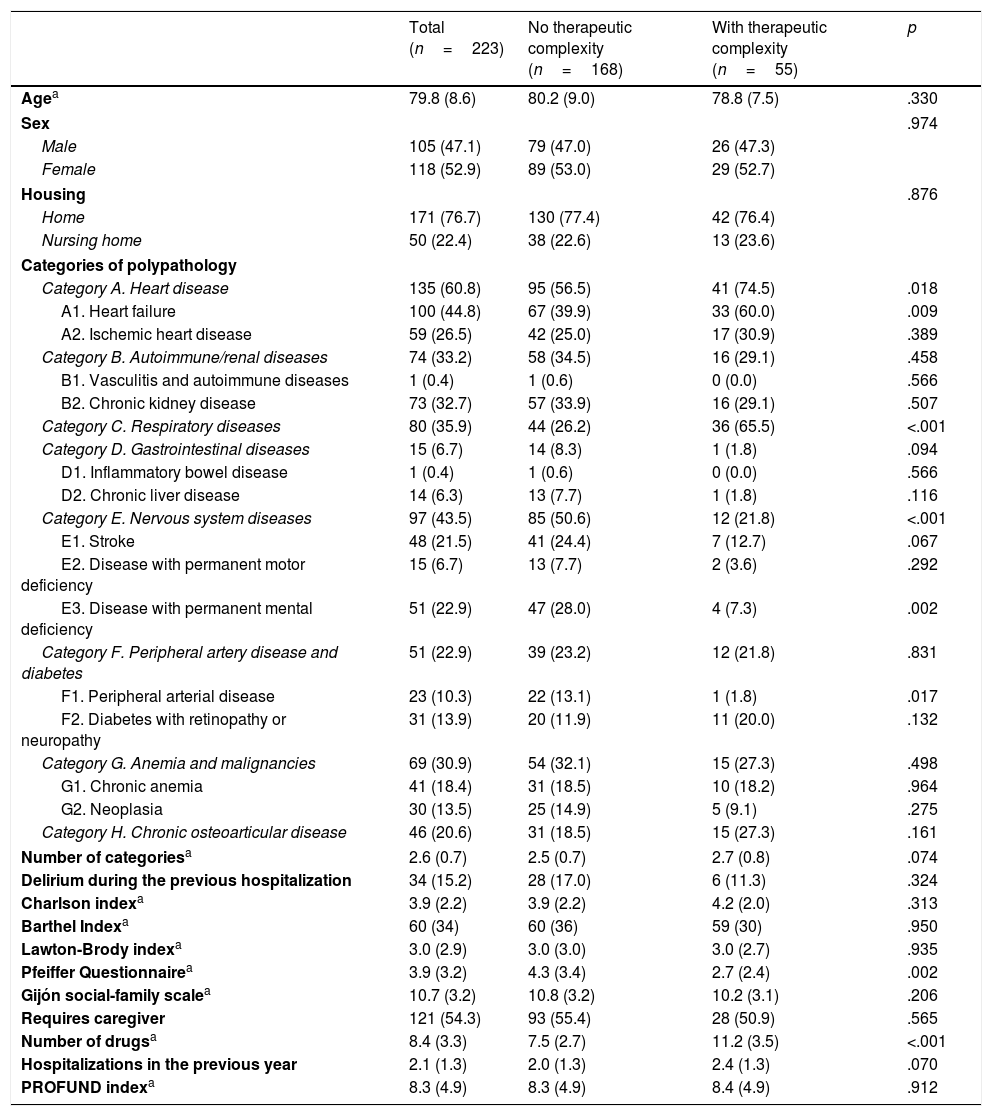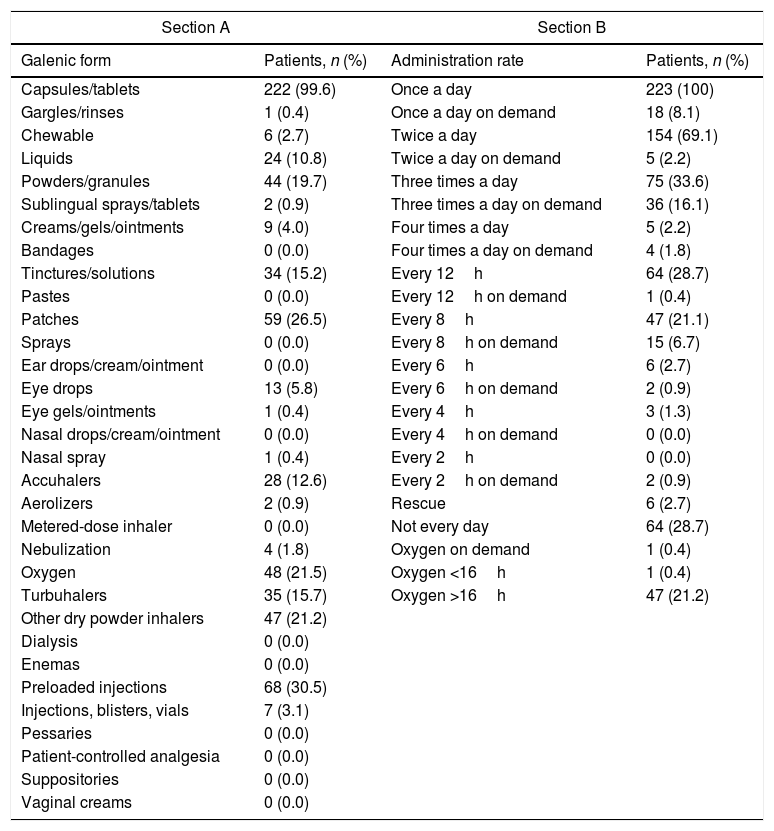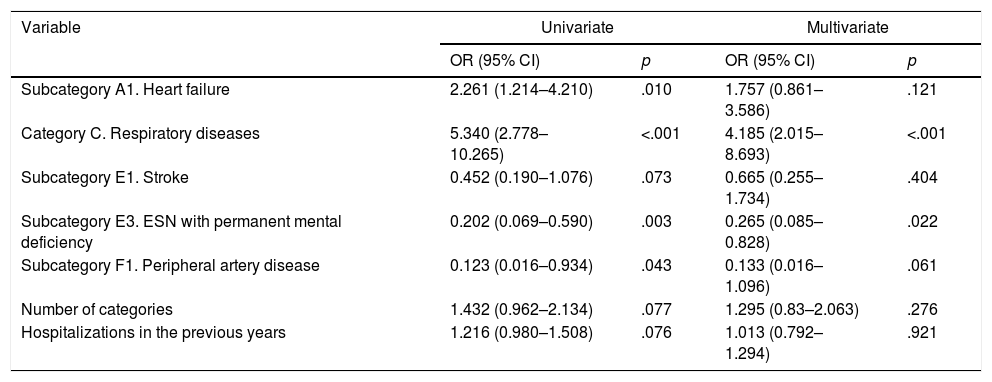To determine the complexity of the therapeutic regimen for polypathological patients hospitalised in internal medicine departments.
MethodsA multicentre observational study included polypathological patients hospitalised in internal medicine departments. Patients who were readmitted or died were excluded. Data were collected on age, sex, residence, disease, Charlson, Barthel and Lawton–Brody indices, Pfeiffer questionnaire, Gijón scale, number of hospitalisations in the previous year, delirium, need for and availability of caregivers and the PROFUND index score. We calculated the therapeutic complexity with the Medication Regimen Complexity Index (MRCI). We considered a therapeutic regimen complex when the MRCI score was in the fourth quartile. To determine the factors associated with complexity, we constructed a logistic regression model.
ResultsWe included 233 polypathological patients, 52.9% of whom were women, with a mean age of 79.8 (SD: 8.6) years. The mean number of drugs consumed was 8.4 (SD: 3.3). The mean MRCI score was 30 (SD: 15.2). The MRCI score by quartiles was 0–20, 20.5–30, 30.5–42, 42.5–80. The respiratory diseases (OR: 4.185; 95% CI: 2.015–8.693; p<.001) were independently associated with increased therapeutic complexity, and the neurological diseases with permanent mental deficiency (OR: 0.265; 95% CI: 0.085–0.828; p=.022) were associated with less complexity.
ConclusionsPatients with comorbidities are polymedicated and have complex therapeutic drug regimens. Respiratory diseases determine greater therapeutic complexity, while cognitive impairment determines a lower therapeutic complexity.
Determinar la complejidad del régimen terapéutico en pacientes pluripatológicos hospitalizados en servicios de medicina interna.
MétodosEn un estudio observacional multicéntrico se incluyeron pacientes pluripatológicos hospitalizados en servicios de medicina interna. Se excluyeron los reingresos y los fallecidos. Se recogieron datos de edad, sexo, residencia, patología, índices de Charlson, Barthel y Lawton-Brody, cuestionario de Pfeiffer, escala de Gijón, número de ingresos en el año previo, delirium, necesidad y disponibilidad de cuidador y puntuación en el índice PROFUND. Se calculó la complejidad terapéutica con el Medication Regimen Complexity Index (MRCI). Se consideró un régimen terapéutico complejo cuando la puntuación en el MRCI estaba en el cuarto cuartil. Para determinar los factores asociados con la complejidad se construyó un modelo de regresión logística.
ResultadosSe incluyeron 233 pacientes pluripatológicos; el 52,9%, mujeres; edad media (desviación estándar): 79,8 (8,6) años. El consumo medio de fármacos fue 8,4 (3,3). La puntuación media (desviación estándar) en el MRCI fue 30 (15,2). La puntuación por cuartiles del MRCI fue 0-20, 20,5-30, 30,5-42, 42,5-80. Las enfermedades respiratorias (OR: 4,185; IC 95%: 2,015-8,693; p<0,001) se asociaron de forma independiente con mayor complejidad terapéutica, y las enfermedades neurológicas con déficit mental permanente (OR; 0,265; IC 95%: 0,085-0,828; p=0,022) se asocian con menor complejidad.
ConclusionesLos pacientes pluripatológicos están polimedicados y tienen regímenes terapéuticos de medicación complejos. Las enfermedades respiratorias determinan una mayor complejidad, y el deterioro cognitivo, una menor complejidad terapéutica.
Article
Diríjase desde aquí a la web de la >>>FESEMI<<< e inicie sesión mediante el formulario que se encuentra en la barra superior, pulsando sobre el candado.

Una vez autentificado, en la misma web de FESEMI, en el menú superior, elija la opción deseada.

>>>FESEMI<<<











